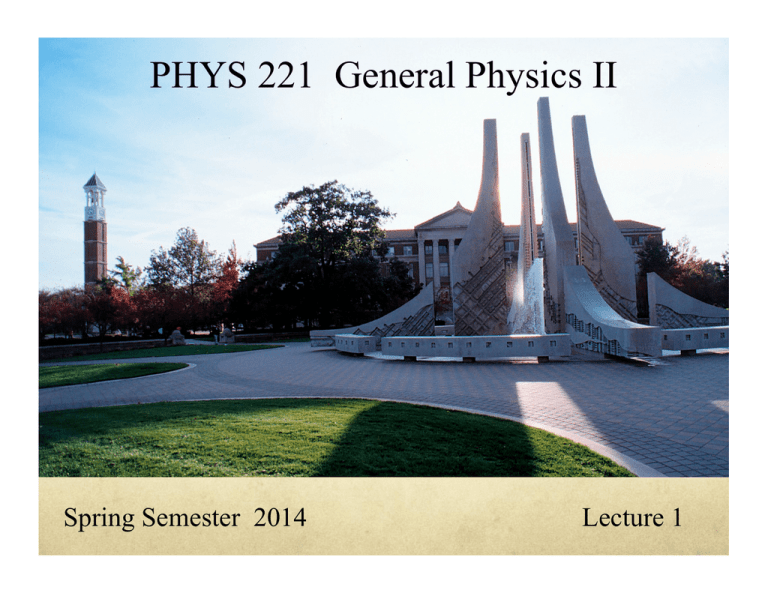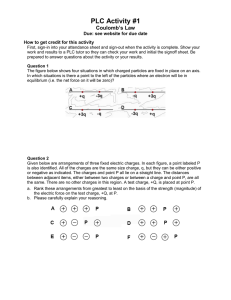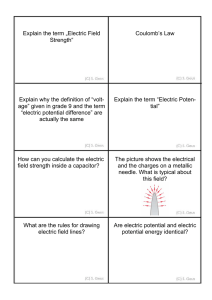PHYS 221 General Physics II
advertisement

PHYS 221 General Physics II Spring Semester 2014 Lecture 1 What we are covering this semester: Introductory physics, using mostly algebra (not calculus), which includes: • • • • • Electrostatics Magnetism Circuits Optics Etc. Some of the information in the Syllabus: Grading will be determined by Midterm Exam 1 – 150 Points Midterm Exam 2 – 150 Points Final exam – 300 Points Homework – 150 Points Lecture (Clicker) Quizzes – 75 Points Lab – 150 Points – You cannot pass the course without passing the laboratory section. Evening Exam Schedule: Tuesday, Feb 25, 8:00 – 9:30 pm Monday, Apr 7, 8:00 – 9:30 pm Final Exam - to be announced. Electric and Magnetic Phenomena " Electric and magnetic forces act on electric charges and currents " Electric charges and currents also act as sources of electric and magnetic fields " Electricity and magnetism are really a unified phenomena " " Called electromagnetism Leads to a theory of electromagnetic radiation " Light is an example " Electromagnetism forms the basis for the study of optics Observational Facts " Discovery of electricity is generally credited to the Greeks " About 2500 years ago " They observed electric charges and the forces between them in many situations " Used amber " A type of dried tree sap " After amber is rubbed with a piece of animal fur, the amber can attract small pieces of dust Section 17.1 Observational Facts, cont. " The Greek word for amber was “elektron” from which we get the words electron and electricity (A) " Modern experiments use plastic and paper (B) " The force occurs even when the plastic and paper are not in contact (C) Section 17.1 Basic Properties of Charges " There are two types of electric charges " They are called positive and negative " Protons have positive charges " Electrons have negative charges " Charge comes in quantized units " All protons carry the same amount of charge, +e " All electrons carry the same amount of charge, -e Section 17.1 Basic Properties, cont. " Like charges repel each other, unlike charges attract " Like charges – both positive or both negative " Unlike charges – one positive and one negative " The “like” and “unlike” apply to the signs of the charges, not their magnitudes Section 17.1 Basic Properties, final " Charge is conserved " The total charge on an object is the sum of all the individual charges carried by the object " Charge can move from place to place, and from one object to another, but the total charge of the universe does not change Section 17.1 What is Electric Charge? Charge is a fundamental property of matter The amount of charge on a particle determines how the particle reacts to electric and magnetic fields An actual definition is not possible The SI unit of charge is the Coulomb In honor of Charles de Coulomb Electron charge = -e = -1.6 x 10-19 C Proton charge = +e = +1.6 x 10-19 C The symbol e is used to denote the magnitude of the charge on an electron or proton The symbols q and Q are used to denote charge in general Section 17.1 Electric Forces and Coulomb’s Law " Electric force can be attractive or repulsive " It is very large " Assume two charged particles can be modeled as point particles " The magnitude of the electric force between the two particles is given by Coulomb’s Law Section 17.2 Coulomb’s Law " Coulomb’s Law says the magnitude of the force between two electric charges is given by " The constant k = 8.99 x 109 N . m2 / C2 " The direction of the force is along the line that connects the two charges " A repulsive force will give a positive value for F " " Between like charges An attractive force will give a negative value for F " Between unlike charges Section 17.2 Coulomb’s Law – Alternative " Another way to write Coulomb’s Law is " " " εo is another constant It is called the permittivity of free space It is equal to 8.85 x 10-12 C2 / N . M2 " The constants are related through " Either form can be used to calculate the force between two particles Section 17.2 Features of Coulomb’s Law " Direction " The product q1 q2 determines the sign " For like charges, the product is positive " The force tends to push the charges farther apart " For unlike charges, the product is negative " The charges are attracted to each other " The form of Coulomb’s Law is similar to Newton’s Law of Universal Gravitation " Both laws exhibit a 1/r2 dependence on the separation between particles Section 17.2 Features of Coulomb’s Law, cont. " Form, cont. " A negative charge can move in a circular orbit around a positive charge " This was the early model for the atom " Gravity is always attractive " Electric forces may be attractive or repulsive " The value of F given by Coulomb’s Law is the magnitude on each of the particles " A force of F on q1 and a force of equal magnitude and opposite direction is exerted on q2 " Newton’s Third Law action-reaction pair Section 17.2 Size of the Electric Force " Assume you have two boxes each containing one gram of electrons " There would be 1.1 x 1027 electrons in each box " The force between the boxes would be 3 x 1026 N " This is almost a million times larger than the force between the Sun and the Earth " Ordinary matter consists of approximately equal numbers of electrons and protons " With equal numbers, Qtotal = 0 and F = 0 Section 17.2 Superposition of Forces " When there are more than two charges in a problem, the superposition principle must be used " Find the forces on the charge of interest due to all the other forces " Add the forces as vectors Section 17.2 Problem Solving Strategy " Recognize the principle " " The electric force can be found using Coulomb’s Law The principle of superposition may also be needed " Sketch the problem " Construct a drawing and show the location and charge of each object " Include a coordinate system " Include the directions of all the electric forces acting on the particle of interest Section 17.2 Problem Solving Strategy, cont. " Identify the relationships " Use Coulomb’s Law to find the magnitudes of the forces acting on the particle of interest " Solve " The total force on a particle is the sum of all the individual forces " Add the forces as vectors " It is usually easier to work in terms of the components along the coordinate system " Check " Consider what the answer means " Check if the answer makes sense Section 17.2






